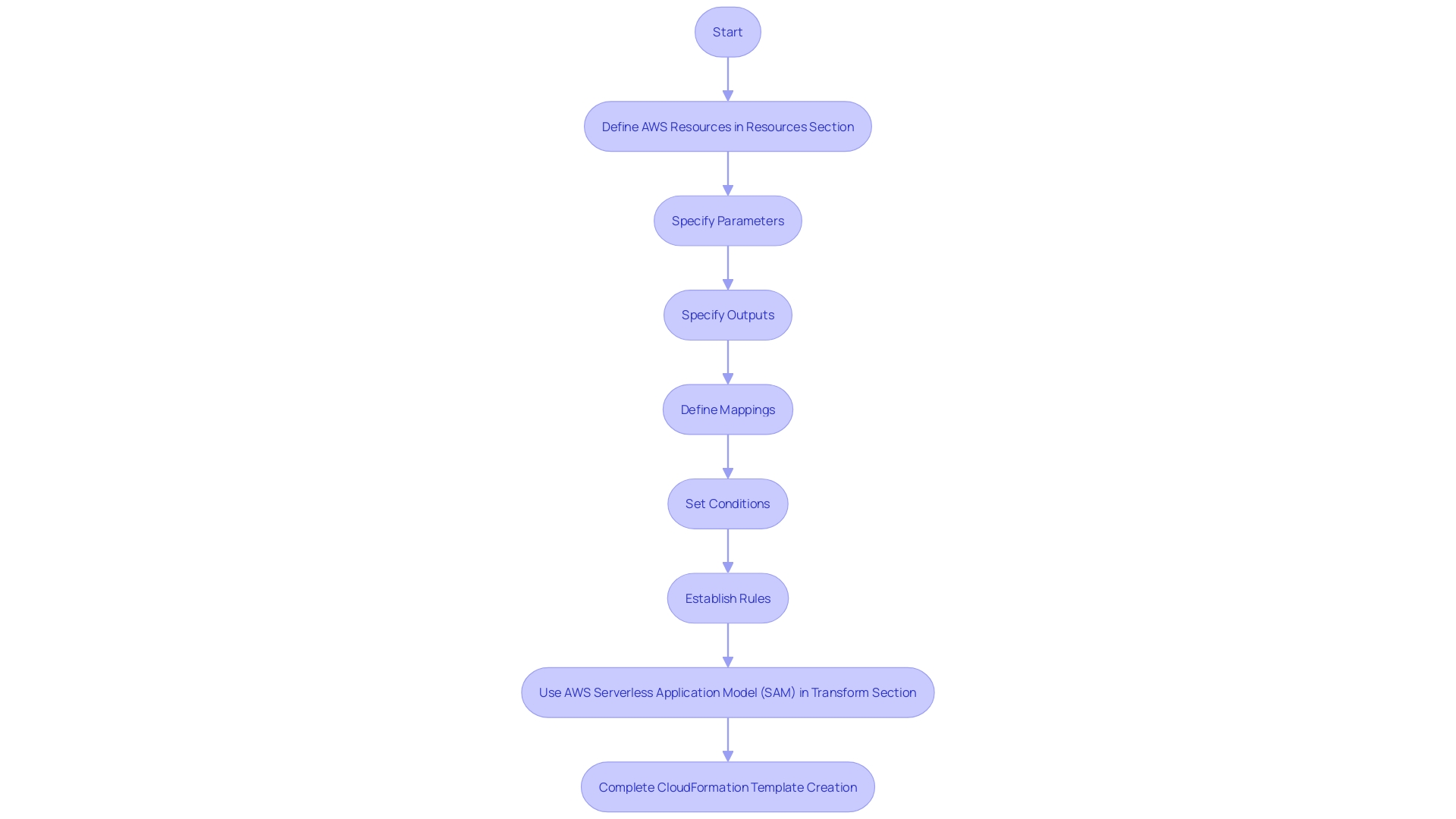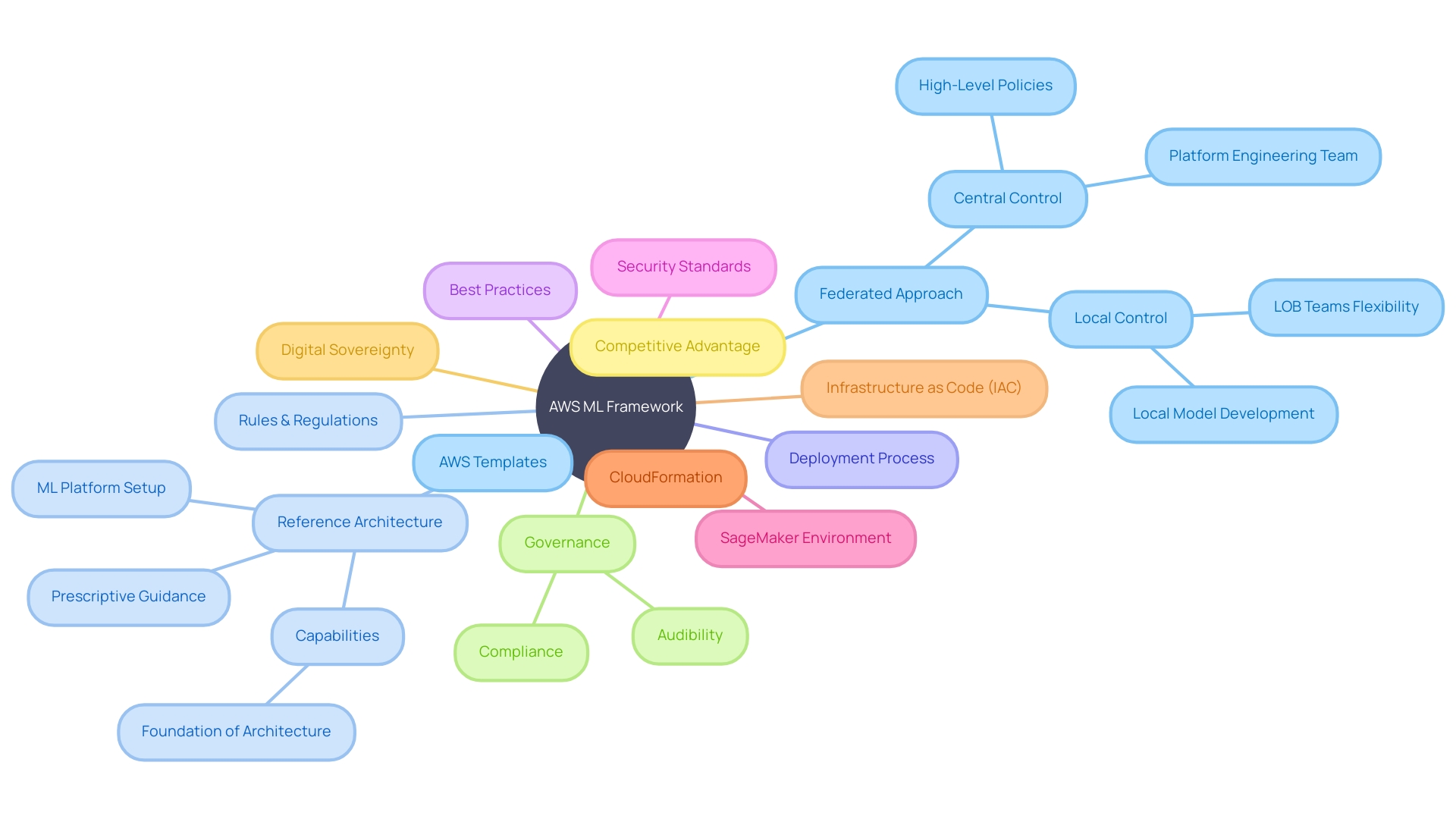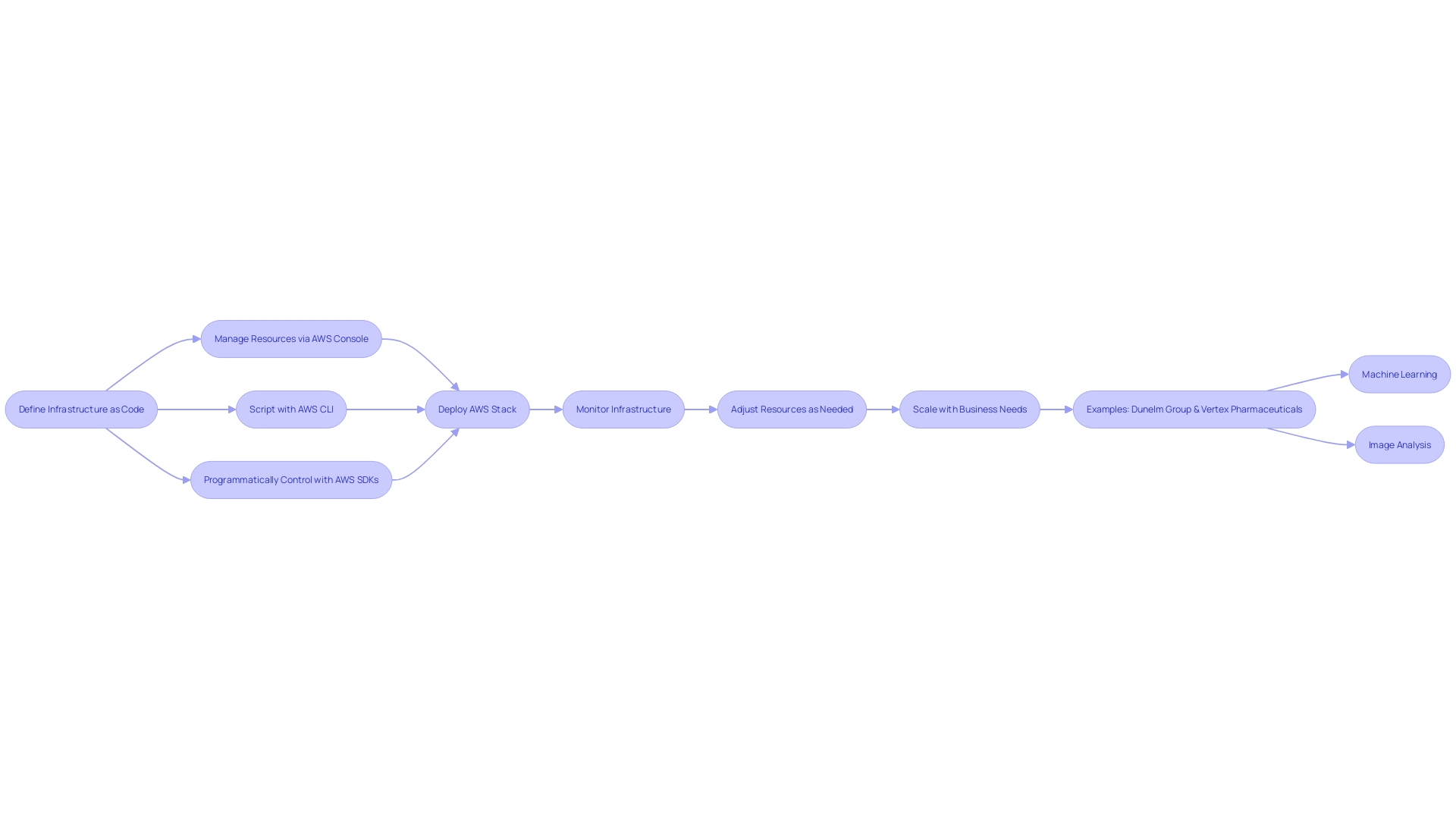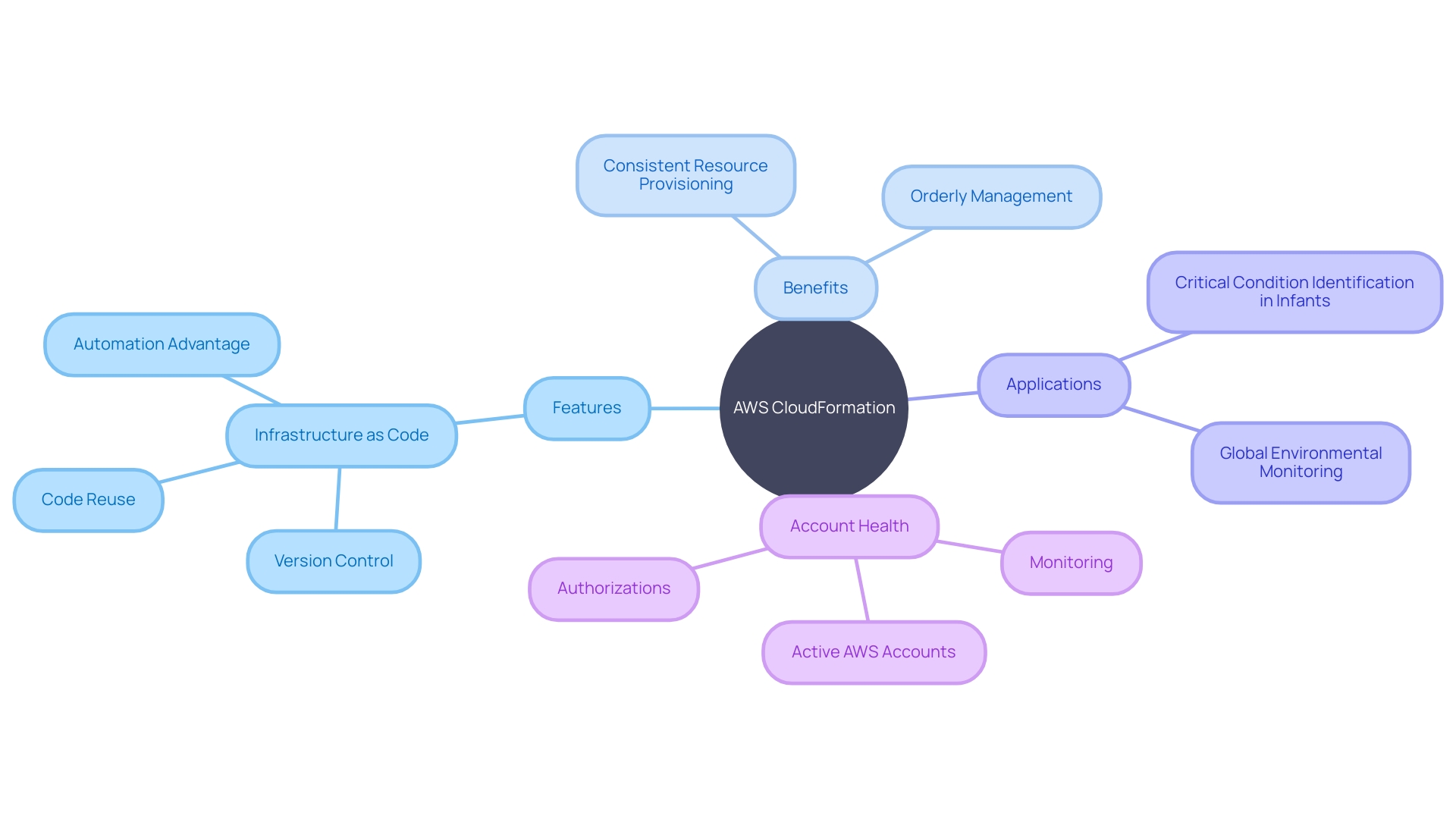Introduction
AWS CloudFormation is a powerful tool that allows developers and businesses to automate and manage the complex infrastructure of AWS resources seamlessly. By using CloudFormation, users can provision their entire AWS environment using a descriptive language in JSON or YAML format, ensuring consistency and repeatability in application deployment. This article explores the key components of AWS CloudFormation, such as the Resources, Parameters, Outputs, Mappings, Conditions, Rules, and Transform sections, and highlights their importance in infrastructure management.
It also showcases real-world examples of organizations, like Dunelm Group and Vertex Pharmaceuticals, leveraging CloudFormation to effectively manage their AWS resources for enhanced scalability and efficiency. With AWS's dominance in the cloud services sector, mastering CloudFormation is essential for maximizing the potential of AWS offerings and staying ahead in the rapidly evolving cloud landscape.
Understanding AWS Stack
AWS CloudFormation is an essential component of the AWS suite, enabling developers and businesses to automate and manage the complex infrastructure of AWS resources seamlessly. By utilizing a service provided by AWS, users can express and allocate all of their AWS environment using a descriptive language in either JSON or YAML format. This approach not only enhances efficiency but also ensures consistency and repeatability in the deployment of applications and services.
An impressive demonstration of the abilities of a certain platform can be seen in the case of Dunelm Group plc, the leading retailer of homewares in the UK. Their shift to a distributed systems architecture to support the substantial digital footprint of their superstores was greatly facilitated by AWS. It allowed them to manage their front end layer effectively, which is crucial given that their website sessions contribute approximately 35% of the company's revenue.
Furthermore, AWS CloudFormation empowers organizations like Vertex Pharmaceuticals to manage complex machine learning workloads. By defining the necessary infrastructure for ML models that analyze microscope images, they can scale their drug discovery process more efficiently. Similarly, AWS's AI and ML services are helping combat global challenges, such as identifying newborns at risk of brain injury or tracking environmental concerns like deforestation.
The versatility of the stack management features of the cloud platform is evident. Stacks enable users to deploy multiple instances of a configuration, thus avoiding redundancy in managing separate configurations. This is particularly useful when rolling out changes across several deployments. The addition of components to a stack further simplifies the composition and deployment of shared lifecycle modules.
For example, when managing AWS resources like EC2 instances, RDS databases, or S3 buckets, the template-based approach ensures all resources are created, configured, and interconnected accurately. Updates are handled by creating a change set, allowing for smooth transitions with minimal disruption to existing resources.
AWS's continued dominance in the cloud industry, as indicated by statistics, underscores the importance of understanding and utilizing a tool like CloudFormation for managing the framework. With AWS dominating the market, it's evident that becoming proficient in the orchestration and automation of AWS resources is essential to harnessing the complete capabilities of AWS's offerings and maintaining a competitive edge in the ever-changing cloud environment.
Key Components of AWS Stack
Amazon Web Services (AWS) offers a set of tools and services that allow for effective management and deployment of resources. At the heart of AWS' infrastructure management is AWS Cloud Formation, which provides a robust method to define, deploy, and update a set of AWS resources in a predictable and controlled manner. Templates are used to describe the desired state of your AWS resources and their relationships, enabling the creation and management of a collection of resources as a single unit, referred to as a 'stack'.
Within a CloudFormation template, various sections play pivotal roles:
- Resources Section: This is the backbone of the template, where you define the AWS resources required for your architecture, such as EC2 instances, RDS databases, or S3 buckets.
- Parameters Section: Here, you can specify values that can be passed to the template at runtime, allowing for customization and reusability of templates.
- Outputs Section: This part outputs the values of specific resources, such as URLs or database connection details, which can be used in other stacks or applications.
- Mappings Section: This section is used for setting up environment-specific parameters to switch between different configuration values based on the environment the stack is deployed to.
- Conditions Section: It allows you to define conditions to control the creation of specific resources based on certain criteria.
- Rules Section: Here, you can enforce validation rules on the template parameters to ensure they meet specific criteria before template deployment.
- Transform Section: This allows the use of AWS Serverless Application Model (SAM) within your infrastructure to simplify the management of serverless applications.
By leveraging these components, organizations like Vertex Pharmaceuticals have been able to streamline their data analysis processes in drug discovery. Moreover, creative applications of AWS services, such as machine learning tools for examining microscope images or for safeguarding against sexual abuse involving children, illustrate the capabilities of AWS in automating and enhancing resource management.
For CTOs and technology leaders, comprehending how to utilize AWS and its components is crucial for architecting solutions that are not only robust and scalable but also cost-effective and aligned with business goals. With the capability to model and manage AWS systems as code, teams can automate deployment processes, decrease the potential for human error, and enhance the speed and agility of their operations.

AWS CloudFormation Templates
AWS CloudFormation is a crucial service within the AWS ecosystem that allows the declaration and provision of AWS resources through code. By using a template, you express the resources and their configurations required for your application stack, enclosed in either JSON or YAML format. These templates serve as the blueprint for your system, establishing the required resources, their specific settings, and the interdependencies that exist among them.
The importance of CloudFormation is multifaceted, offering a consistent, version-controlled, and automated approach to deployment. This is not only a best practice but a strategic advantage, fostering an environment where changes to the underlying systems are treated with the same rigor as software developments. As underscored by the extensive adoption of IAC solutions, the method of codifying infrastructure ensures that your environments are consistently provisioned, mitigating configuration drift and enabling a predictable, repeatable deployment process.
Furthermore, the adaptability of templates enables customization to comply with specific regulatory needs, an essential in operational settings. This flexibility is further demonstrated through use cases such as deploying a SageMaker environment to facilitate Text-to-SQL experiments using models like Llama 3, where templates are crucial in setting up the necessary AWS resources.
The role of infrastructure management is further accentuated by the growing complexity of cloud environments and the need for cost-aware, sustainable architectures, as highlighted by Werner Vogels, Amazon.com Vice President and CTO. The service empowers developers to think of cost as a fundamental aspect of development, aligning closely with business objectives that often prioritize cost savings and operational efficiency.
Essentially, AWS IaC represents the transformative essence of Infrastructure as Code. It encapsulates the strategic shift towards automated, code-driven management of systems, ensuring that organizations can leverage the full potential of cloud computing while maintaining control, compliance, and cost-effectiveness.
Resources Section
In the domain of Amazon Web Services (AWS), the CloudFormation service emerges as a crucial tool facilitating the specification and deployment of a comprehensive AWS system via code. By using a template, it is possible to carefully outline the necessary resources along with their specific configurations and interdependencies, effectively creating a stack. The template becomes the foundation of deployment, facilitating a systematic and reproducible process that ensures consistency across environments.
The Infrastructure as Code (IaC) model offers numerous advantages. For instance, it enables version control of infrastructure blueprints, supports code reuse for efficient resource management, and aligns infrastructure modifications with software development practices. The automated provisioning that this service provides not only streamlines the setup process but also reduces the potential for human error, thereby increasing reliability and stability within the AWS ecosystem.
The service encompasses an extensive array of AWS offerings, with over 100 products accessible through the AWS Free Tier, catering to both experimentation and education. This generosity allows newcomers to familiarize themselves with the capabilities of the cloud service without immediate cost, albeit with certain limitations post the initial 12-month period following account setup.
In practice, CloudFormation templates play a crucial role in diverse projects, such as deploying a SageMaker environment for Text-to-SQL experimentation with Llama 3. This particular use case underscores the importance of monitoring service quotas and adhering to AWS's guidelines, including the acceptance of end-user license agreements (EULA). Furthermore, it emphasizes the need for validating and thoroughly testing system code before its deployment in production scenarios, ensuring that it meets the rigorous standards required for enterprise applications.
In the AWS framework, the ultimate power of IaC to revolutionize the way organizations conceive and manage their cloud-based resources lies in its ability to handle the structure and Cloud Formation as it would application code, with the same level of precision and rigor.
Parameters Section
The AWS service is a powerful feature of the AWS suite, designed to simplify the management of resources for developers and businesses alike. It enables you to define and provision all the necessary AWS resources through a declarative text file called a template. This template acts as a blueprint for your AWS environment, detailing the resources and configurations required. Notably, the Parameters section of the template brings flexibility and customization to the table by allowing you to input specific values at the time of stack creation. These parameters are instrumental in tailoring your stack to meet the unique needs of your applications and can significantly influence how your stack behaves and operates.
Using the CloudFormation tool offers numerous benefits, such as automating the provisioning of resources, which aids in minimizing human mistakes and saving time. This automation is constructed based on the Infrastructure as Code (IAC) principle, enabling consistent deployment of environments, version control, and effortless replication of your setup. Moreover, as AWS regularly introduces new features and best practices, keeping your templates updated ensures that your infrastructure remains secure, cost-efficient, and aligned with the latest advancements from AWS.
However, it's paramount for developers to understand that the templates and code samples provided, like those for setting up a SageMaker Environment or for educational purposes, are intended as starting points. They require careful review, testing, and adaptation to comply with security best practices and organizational standards before being deployed into production environments. Monitoring and managing quotas is also a crucial practice to ensure that your deployments align with your usage requirements and that quota increase requests are addressed in a timely manner by AWS engineering teams.
The significance of AWS and its offerings such as the cloud platform is emphasized by the dependence of businesses and government agencies on it. The flexibility and scalability offered by AWS make it an indispensable tool for organizations of all sizes. This is further emphasized by recent commitments to expand AWS facilities, like the announcement of an independent European cloud, demonstrating the critical role that AWS plays in supporting digital sovereignty and meeting stringent regulatory requirements.
To summarize, AWS CloudFormation is a crucial tool for modern cloud management, offering a solid framework for IaC practices. It empowers organizations to build and manage their AWS resources with greater precision, efficiency, and alignment with evolving digital strategies.
Outputs Section
AWS CloudFormation's Outputs section is a vital part of the management process, serving as the mechanism for sharing resource references and values across multiple stacks or with external systems. This capability is essential for creating interconnected environments where, for instance, a deployed SageMaker environment utilizes Text-to-SQL with Llama 3 models, and these resources need to be managed effectively to ensure sufficient service quotas and adherence to end-user license agreements. Understanding and managing Outputs is also vital for applications like the Q Business application, which relies on collected data to generate valuable insights.
The Outputs section can include a descriptive argument to clarify the purpose of each output. This is especially beneficial in collaborative environments where team members need to comprehend the system without delving into the code. For example, while some outputs may seem straightforward, others may be more complex, and the 'description' field can greatly enhance comprehension.
In the context of Infrastructure as Code (IaC), AWS CloudFormation provides a consistent and version-controlled method for defining and deploying architectural elements, which is exemplified by the 'depends_on' argument. This argument is used to establish explicit dependencies, ensuring that resources like security groups are in place before they are accessed, thereby preventing connection issues.
The tactical utilization of AWS's cloud deployment framework is emphasized by its implementation for constructing autonomous European digital systems, as demonstrated by AWS's dedication to extending its network with a separate European cloud, tailored to the strict regulations of corporations and governmental institutions. This expansion is particularly beneficial for the German 'Mittelstand' and other entities requiring a high level of digital independence.
In summary, the Outputs section not only facilitates the referencing of AWS CloudFormation-managed resources but also embodies the principles of IAC, fostering a robust, scalable, and governance-compliant infrastructure.
Mappings Section
Within AWS, the Mappings section functions as a pivotal construct, allowing developers to define intricate associations between distinct values and corresponding criteria. This feature is particularly advantageous when varying outputs are warranted, contingent upon specific inputs or conditions. Leveraging this functionality, it's possible to delineate mappings that dictate which value should be applied in a given scenario, facilitating a dynamic and responsive template configuration. For instance, the Mappings section can be used to determine the suitable Amazon Machine Image (AMI) based on the specified region or environment. This mechanism underscores the service's commitment to providing a robust system as code (IAC) solution, designed for automation and efficient management of AWS resources.
Conditions Section
Within the realm of AWS, the 'Conditions' section plays a pivotal role in the creation and execution of infrastructure deployments. This section empowers you to define predicates that govern the instantiation of resources or the execution of specific portions of your template. Leveraging conditions, you can tailor the provisioning process based on various factors such as input parameters from users, intrinsic properties of resources, or even other predefined conditions.
For instance, when orchestrating an AWS environment for a scalable application, you could specify conditions to selectively deploy resources in different environments like development, staging, or production. This conditional logic ensures that resources are provisioned only when necessary, optimizing cost and efficiency.
Think about the situation of establishing an IAM role in a template—a crucial step for securing AWS services. You might include a condition to check whether an IAM role with the desired permissions already exists, thereby avoiding redundant resource creation. By using the iterative examples given in guides, the implementation of such conditions is explained, demonstrating the practicality and significance of conditional logic in templates.
As the cloud landscape evolves, the ability of the cloud orchestration tool to integrate conditions becomes even more critical. It not only streamlines the deployment process but also aligns with the best practices of Infrastructure as Code (IAC), allowing for repeatable, predictable, and automated infrastructure management. This approach is crucial as it helps maintain governance and compliance standards, especially in organizations deploying at scale, such as those managing extensive AWS footprints across diverse regulatory environments.
Rules Section
AWS templates provide a robust mechanism for defining and deploying a full spectrum of AWS resources in a consistent and repeatable manner. The incorporation of Rules within these templates adds an essential layer of validation, ensuring that the properties set forth align with the required configurations. This validation is not just a matter of formality but a critical step in the deployment process, given the complexities and potential scale of AWS stacks. By stipulating constraints and conditions through Rules, developers can construct a safeguard against common deployment pitfalls, thereby reinforcing the integrity of the stack during both creation and updates.
The Rules section is particularly valuable when it comes to educational and experimental setups, as evident in the deployment of a SageMaker Environment using a provided template, where adherence to best practices, such as monitoring quotas, is recommended. While these templates serve as convenient starting points, they are intended to be adapted and rigorously tested to ensure they meet the stringent security standards required for production environments.
Furthermore, the strategic implementation of Regulations within templates resonates with the broader AWS ethos of providing scalable, flexible, and secure cloud solutions. As AWS continues to expand its network and offerings, such as the announcement of a separate European cloud, the significance of CloudFormation as a tool for Infrastructure as Code (IAC) becomes increasingly apparent. It allows organizations to effectively manage their digital systems with precision, aligning with digital sovereignty requirements and contributing to their competitive advantage in the global market.

Transform Section
AWS Transform section is an essential tool for developers looking to deploy intricate cloud infrastructure with effectiveness and accuracy. By specifying macros or the AWS Serverless Application Model (SAM), this section allows for the transformation of the template, streamlining your deployment process.
For instance, consider a CloudFormation template designed to set up a SageMaker environment for experimenting with Text-to-SQL using Llama 3. By utilizing macros, developers can guarantee that they adhere to best practices such as monitoring quotas and managing end-user license agreements (EULA) effectively. Leveraging the Transform section helps mitigate the risks associated with deploying to production environments by providing a means to request service quota increases and ensuring compliance with AWS's stringent review processes.
Moreover, the Transform section is particularly valuable when using Infrastructure as Code (IaC) practices. It offers consistency by eliminating configuration drift, ensuring that your environments are provisioned identically every time. This method not only enables version control and code reuse but also equips teams to handle changes with the same rigor as software changes. Automation is another key advantage, streamlining provisioning and reducing the potential for human error.
The widespread use of AWS services, as demonstrated by the effect of AWS outages on everyday existence, highlights the significance of sturdy system administration. With the use of this platform, businesses can scale at their own pace, benefiting from its affordability and flexibility. The recent announcement of an independent European cloud by AWS further highlights the company's commitment to providing organizations with the digital sovereignty and compliance options necessary to thrive in a competitive global market.
To summarize, the Transform section of an AWS template is not only a functionality but a strategic element that enhances the deployment of scalable, secure, and compliant cloud resources. Its capability to streamline and improve the provisioning process makes it a crucial element of the AWS platform.

Getting Started with AWS Stack
Engaging with AWS Stack requires a foundational grasp of AWS CloudFormation, a pivotal tool for defining and provisioning AWS infrastructure using code. It is crucial to familiarize oneself with the AWS Management Console for interactive management, the AWS Command Line Interface (CLI) for scripting, and AWS SDKs to programmatically control AWS offerings. For instance, Dunelm Group plc, a leading UK retailer with substantial online revenue, leveraged the power of AWS to scale their digital platform effectively as their operations grew. Similarly, Vertex Pharmaceuticals utilized AWS to expedite drug discovery through machine learning and image analysis, illustrating the transformative impact of AWS on data-intensive tasks. As AWS continues to dominate the cloud services market, surpassing competitors with its extensive offerings, businesses can leverage AWS to facilitate growth, innovation, and efficient scalability. The initial tangible action is building a stack using an AWS template, which encompasses the resources and configurations required for application deployment, reflecting the collaborative and iterative nature of DevOps culture. By starting with a cloud-based deployment tool, organizations can automate and streamline their setup to match the dynamism of contemporary software development and operations.

Creating a Stack from a Template
AWS CloudFormation is an essential service within AWS, allowing you to define and provision a collection of related AWS resources in a consistent and orderly manner. By utilizing a template, you are able to deploy resources like servers, databases, and networks, without the need for manual configuration. The process to set up a stack from a template is efficiently streamlined, allowing you to employ either the AWS Management Console, the AWS Command Line Interface (CLI), or the AWS Software Development Kits (SDKs) to submit your template and any requisite parameters. Afterwards, the AWS service carries out a meticulous validation of your template before proceeding to establish the stack conforming to your outlined specifications.
By embracing the model of Infrastructure as Code (IaC), CloudFormation ensures that your management of the underlying system is as agile and manageable as your software development. You can benefit from version control, code reuse, and consistent handling of changes to the underlying systems. Moreover, it offers an automation advantage, drastically reducing the manual effort typically associated with infrastructure provisioning.
Present uses of the cloud deployment service encompass a range of cutting-edge domains. For example, companies are utilizing AWS offerings to quickly identify critical conditions in infants or to aid in global environmental monitoring. These applications emphasize the critical significance of dependable and scalable cloud infrastructure, facilitated by platforms like CloudFormation.
In the dynamic world of cloud computing, where uptime and reliability are paramount, AWS maintains a strong health dashboard, consistently updated to reflect the latest status of AWS offerings. This transparency allows users to monitor their account health and the performance of their cloud resources in real-time.
Prior to starting with the AWS service for infrastructure management, it is essential to have an active AWS account and obtain the required authorizations by configuring an AWS Identity and Access Management (IAM) role and user. This ensures you can create and manage the resources required for your application. Moreover, for more sophisticated implementations, you may have to apply for access to particular AWS offerings or models, like Amazon Bedrock LLMs, to enhance the capabilities of your application.
In conclusion, AWS CloudFormation is an indispensable tool that aligns with the strategic needs of businesses, helping them deploy cost-effective, sustainable, and modern architectures. It stands as proof of the transformative power of cloud solutions in speeding up and expanding application deployment while aligning with the broader business goals.

Deploying Applications with AWS Stack
AWS Cloud Services provides a robust platform to streamline the deployment of applications across various environments with efficiency and consistency. Utilizing templates to define infrastructure and offerings, it allows for straightforward replication and administration of application environments from development to production. The platform's capability to automate resource creation and configuration aids businesses in scaling their digital offerings in line with their growth. For example, Dunelm Group plc, a prominent UK homewares retailer, employs such solutions to bolster their extensive digital platform, which is accountable for a substantial portion of their revenue.
Employing AWS offerings, companies can establish their application with a name and description, then effortlessly append resources using AWS Resource Explorer. This includes the integration of resources by keyword, tag, or AWS CloudFormation stack, streamlining the full lifecycle management of applications. The automated generation of the myApplications dashboard, along with new AWS Application tags, further facilitates efficient applications management.
Moreover, Amazon CloudWatch Application Signals automates the instrumentation of applications, adhering to best practices for performance without the need for manual effort or custom code. This results in a standardized dashboard showcasing crucial metrics such as request volume, availability, and latency. Businesses can define Service Level Objectives (SLOs) for critical operations, enhancing the monitoring of application performance.
The complex structure of distributed systems, consisting of many interconnected components, presents difficulties for performance monitoring. Traditional methods require manual assembly of telemetry signals, which can be time-consuming and inconsistent. AWS addresses these challenges by providing tools like Amazon CloudWatch Application Signals, which automatically instrument applications and streamline performance analysis.
In the realm of cloud computing and AI, AWS has been instrumental for organizations like GoDaddy, which serves over 20 million customers. GoDaddy's commitment to data-driven decision making and customer satisfaction is supported by AWS's cloud capabilities. The platform's design considerations for availability and resilience are exemplified by Amazon ECS, which anticipates potential failures and is architected for high availability and quick recovery. Even with a 99.99% availability rate, AWS anticipates background failures and designs services like Amazon ECS to minimize their impact, ensuring customers can maintain operations with confidence.

Advanced Use Cases
As you progress in your AWS journey, the opportunities for optimization and advancement in your application deployment process are vast and compelling. For instance, you can improve your system by utilizing the cross-stack references feature, enabling outputs from one AWS CloudFormation stack to be used in another, thereby creating a highly connected and efficient environment.
One case in point is ICL, a multinational manufacturing corporation, which faced the challenge of monitoring industrial equipment under extreme conditions. Through AWS, they were able to simulate real-time measurement data and transform their traditional manual monitoring processes into a scalable, cloud-based solution. This not only improved operational efficiency but also addressed safety concerns by minimizing the need for continuous on-site personnel presence.
Moreover, with the advent of Amazon EC2 instances, deploying applications has become more streamlined. It allows for the setup of scalable, load-balanced applications that can adapt to varying loads, ensuring that performance is consistent and reliable. This is crucial in sectors such as pharmaceuticals, where Vertex Pharmaceuticals utilized AWS to accelerate the drug discovery process. They implemented machine learning techniques to analyze experimental data, enhancing the accuracy and speed of their research outcomes.
In the context of digital transformation, AWS's infrastructure expansion with an independent European cloud is particularly noteworthy. It empowers organizations, especially the robust German 'Mittelstand', to meet stringent digital sovereignty requirements while maintaining competitiveness on a global scale.
The architecture of your cloud environment can mirror the agility of your business needs. By deploying multiple instances of edge software on a single device, you can overcome supply chain delays and avoid the procurement of additional hardware for each environment, as exemplified in AWS's approach to modernization.
Generative AI is another frontier where AWS is making strides. With offerings like Amazon Q Business, you can leverage AI-powered assistance to obtain accurate information rapidly, enhancing decision-making processes. This capability is revolutionizing how enterprises interact with their data and systems, as seen with support engineers and project managers integrating generative AI with platforms like ServiceNow for improved customer support.
Interestingly, AWS's dominance in cloud technology is evident from its overwhelming market share, which is more than double that of its nearest competitor. This reflects the trust and reliance placed by developers and companies on AWS for hosting their applications, databases, and services.
To sum up, the advanced use cases of AWS provide a pathway for companies to modernize, innovate, and achieve operational excellence, firmly establishing them as leaders in their respective industries.
Referencing Outputs in Another Stack
AWS provides a powerful feature allowing outputs from one stack to be used in another, facilitating the construction of sophisticated application architectures that interconnect multiple stacks and utilize the resources built within each. For instance, when processing PDF documents for text and tables, an application might leverage Amazon Textract, followed by a text embedding model to generate vectors for each text chunk.
This capability was highlighted in a case where an AWS CloudFormation template was crucial as a starting reference for development, emphasizing the need for careful evaluation and modification to align with security best practices. Furthermore, AWS's scalability, speed, and cost-effectiveness make it a preferred choice for businesses, underscored by the critical nature of AWS outages due to the platform's wide adoption.
Amazon Web Services acts as a foundation for companies, providing cloud computing solutions and APIs that allow businesses to grow flexibly. In the realm of open-source projects, developers often deliberate on where documentation is most effectively accessed, be it within the project repository or alongside integrated technology documentation.
Additionally, the impact of AWS extends to real-time data analysis, with companies like Clarity AI parsing news from thousands of sources daily to evaluate sustainability risks using advanced NLP models. This demonstrates the extensive reach and integration of AWS offerings in various aspects of business intelligence and decision-making.
The multifaceted use of AWS CloudFormation, from initial development stages through to production deployment, underscores its significance in the technology ecosystem, where choices in software development tools can significantly influence both developers' career trajectories and the technological agility of businesses.
Deploying Applications on Amazon EC2
Amazon Web Services (AWS) provides a strong cloud computing platform that not only dominates the market in share but also offers a variety of offerings enabling organizations to deploy applications efficiently. Utilizing AWS, companies can automate the deployment of applications on Amazon EC2 instances with the help of templates that encapsulate the required resources and configurations. This smooth automation of provisioning and management empowers businesses to concentrate on innovation and growth instead of getting entangled in the complexities of setup.
The strategic importance of AWS is highlighted by its extensive ecosystem, which includes vital components like Virtual Private Cloud (VPC), Elastic Container Service (ECS), and Identity and Access Management (IAM). Moreover, AWS's commitment to security is evident through its multi-layered approach to data protection, which is paramount for any data-driven organization. This commitment is reinforced by extensive documentation and learning resources that make AWS an accessible platform for both novices and seasoned professionals.
Real-world applications of AWS's capabilities are vast and impactful. For instance, Vertex Pharmaceuticals leveraged AWS's machine learning tools to revolutionize drug discovery, enhancing the analysis of experimental data and accelerating therapeutic advancements. This highlights AWS's ability to handle complex, data-intensive tasks with efficiency.
Furthermore, AWS's scalability and flexibility are well-recognized, allowing businesses to adjust their resources to match their growth pace. Its expansive infrastructure assists startups at different stages, as observed with the NVIDIA Inception program, which incorporates AWS offerings to aid startups in utilizing state-of-the-art technology and establishing connections with investors.
With the cloud computing landscape becoming increasingly competitive, AWS continues to evolve, as reflected by the decreasing spend on EC2 instances in favor of advancements in AI and other offerings. As businesses continue to acknowledge the benefits of cloud solutions, AWS's position as a enabler of innovation and business development remains firmly established in the technology ecosystem.

Creating a Scaled and Load-Balanced Application
AWS Cloud Services provide essential tools for organizations aiming to scale their digital platforms efficiently. Critical to this scalability is the ability to manage traffic distribution and maintain uptime even under high demand. The AWS Elastic Load Balancer (ELB) is a fully managed solution that addresses this need head-on by efficiently routing incoming network traffic to multiple servers, ensuring no single server becomes overloaded. This prevents potential bottlenecks, allowing applications like Dunelm Group plc's e-commerce platform, which accounts for a significant portion of their revenue and attracts over 400 million sessions annually, to operate smoothly.
By utilizing features like ELB and Auto Scaling Groups, AWS enables businesses to manage fluctuating levels of traffic, an aspect demonstrated by the development of a Generative AI application using Amazon Bedrock. This application, which assists teachers in creating educational materials and students in learning English, relies on AWS's robust infrastructure to manage its operations, demonstrating the platform's broad utility.
Amazon's commitment to high availability and resilience is evident in the design of Amazon ECS, which is built to handle the inevitability of system failures. Even with a 99.99% availability rate, a large-scale operation could anticipate some level of interruption in provision. However, AWS's architecture is designed to mitigate such disruptions, emphasizing rapid recovery and continuous provision, as illustrated by the resilience metrics used to measure how swiftly services like the cupcake-selling website can recover from outages.
The underlying message from industry leaders like Steve Jobs, who famously said, "The only way to do great work is to love what you do. Don't be afraid to take risks and embrace new technologies, because that's where the real learning happens," resonates with AWS's approach. Embracing cloud solutions is not only about adapting to new technologies; it's about leveraging them to create applications that are not only scalable and available but also resilient in the face of adversity. AWS's suite of services embodies this philosophy, enabling organizations to focus on their unique business needs while relying on AWS to maintain the performance and availability of their cloud applications.
Conclusion
In conclusion, AWS CloudFormation is a powerful tool that automates and manages AWS infrastructure seamlessly. It allows users to provision their entire AWS environment using a descriptive language, ensuring consistency and repeatability in application deployment. Mastering CloudFormation is essential for maximizing the potential of AWS offerings and staying ahead in the rapidly evolving cloud landscape.
Real-world examples, like Dunelm Group and Vertex Pharmaceuticals, highlight the effectiveness of CloudFormation in managing AWS resources for enhanced scalability and efficiency. CloudFormation enables organizations to effectively manage their frontend layer and scale machine learning workloads for drug discovery processes.
CloudFormation templates provide a consistent, version-controlled, and automated approach to infrastructure deployment. The flexibility of templates allows customization to adhere to specific compliance requirements and ensures consistent provisioning, reducing configuration drift.
The various sections of CloudFormation templates enable users to define resources, specify runtime values, output resource values, set up environment-specific parameters, define conditions, enforce validation rules, and simplify the management of serverless applications.
AWS CloudFormation is an essential tool for modern cloud infrastructure management. It empowers organizations to build and manage their AWS resources with precision, efficiency, and alignment with evolving digital strategies. By utilizing CloudFormation, businesses can automate deployment processes, reduce errors, and increase operational speed and agility.
With AWS's comprehensive suite of services and commitment to security, scalability, and reliability, CloudFormation remains a trusted solution for infrastructure management in the rapidly evolving cloud landscape. Mastering CloudFormation is crucial for leveraging the full potential of AWS services and ensuring efficient infrastructure management.




